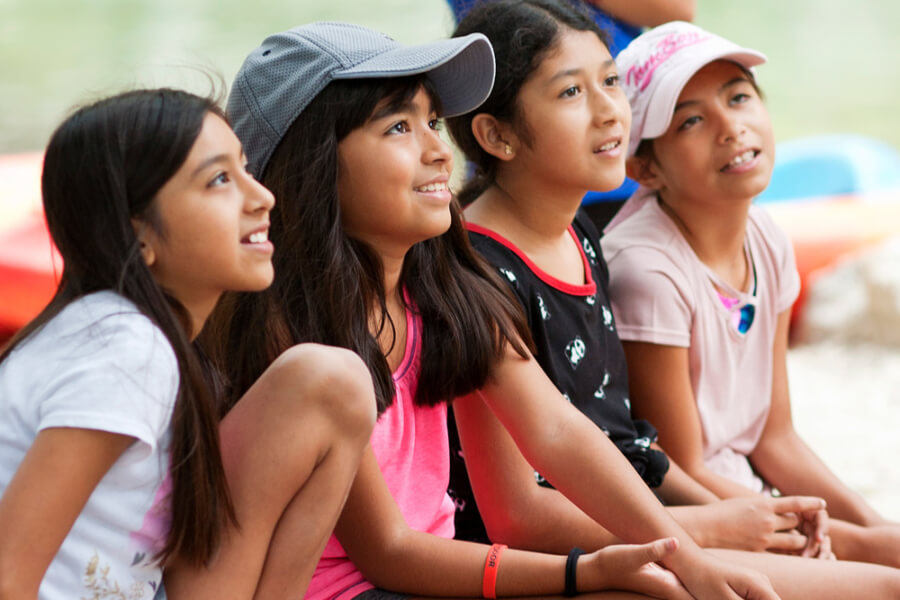
![]()
Subiendo? calls a timid, child’s voice. Going up?
Sube! answers a reassuring adult voice. Go up!
With that, a fifth-grader named Joshtin began climbing the 75-foot Alpine Tower, one of the iconic features of H. E. Butt Foundation Outdoor School. Joshtin was one of about 90 fifth graders from Perez Elementary—a school in the Austin Independent School District—visiting the Canyon in mid-October. Their teacher, Kari Johnston, has brought a group, either to Outdoor School or Foundation Camp, every year for the past eight years.
As the oldest student group in the school, the sleepaway, outdoor experience is a “rite of passage” for these 10-12 year-olds each year, Johnston said. “It’s kind of become the culture at Perez.”
At first, the school thought of the two-night trip as a chance to get the kids out into nature. City kids, especially those whose parents might work on the weekend, don’t get much exposure to immersive nature—certainly not the kind they experience in the Canyon.
The majority of the 1,850 students who participated in Outdoor School in 2019 come from schools like Perez—schools in large cities where the vast majority of students qualify for the federal free and reduced lunch program. Research has shown that getting students outside, surrounded by the natural world, reduces stress and stimulates imagination.
But there’s another layer to Outdoor School. When nature is combined with challenges like kayaking, ropes courses, mountain biking, rappelling, and orienteering—that’s when things really start to come alive for the kids, Johnston has observed. “These are things they are going to remember forever,” she said.

Many people who grew up in middle class families have an empowering memory of outdoor adventure. A mountain climbed. A rapid run. A cliff jumped. But students at Perez aren’t as likely to encounter a climbing harness, kayak, or auto-belay as their wealthier peers might at summer camps throughout elementary, middle school, and high school. They aren’t as likely to spend the night away from home in a fun, safe setting where they get to be something between a child and an adult in all the best ways.
At the same time, Joshtin’s temerity on the tower is a bit ironic—or maybe telling. He has done far more dangerous things in his ten years.
Johnston recalls a moment earlier in the year when Joshtin and several other Spanish-speaking classmates gathered around a world map in the classroom. They were tracing lines from Honduras to Austin. They asked Johnston for a more detailed map.
On a map of Central and North America, each student showed her their route from their hometown in Honduras, up through Guatemala and Mexico, to where they had entered the United States to ask for asylum.
They told her about walking. Hitching rides. La Bestia—the notorious northbound train that plays a central role in the harrowing journey of many migrants. There were no harnesses holding them safely to the beds of the large trucks as they rode northward. No trained, adult belaying them as they clung to the top of the train.
Now, here was Joshtin, perfectly safe, and yet utterly terrified, clinging to a platform about one-third of the way up the tower.
After everything, he is still a ten-year-old kid.
At the lowest platform, Joshtin signaled that he wanted to come down. It was his choice, Johnston affirmed. Control over how high to climb, which route to take, and when to come down is one of the ways Outdoor School staff help students summon the courage to take on the tower. “It’s your choice,” they say.
When the students know they are in control, and that no one will leave them stranded or push them beyond their limit, many students push for the top of the tower. Just 15 minutes earlier, Mia, a little girl with waist-length black hair, had hoisted herself onto the top platform amid cheers from below.
But “It’s your choice” also gives some kids the courage to end their journey on a lower platform. They find their limit, and rather than seeing it as a failure to reach the top, they have the confidence to stop at a different place along the way.
Some of the students, like Joshtin, start out unsure. Others start out confident, cocky even, only to reach the first respite platform with knees too shaky to continue. Even though there is plenty of celebration from their classmates as the belaying staff member lowers them to the ground, some are disappointed, ashamed they could not make it further.
One such girl collapsed into tears as her feet touched the ground. The nerves and the disappointment gushed out of her eyes in big, heaving, sobs as Johnston ran to her side. Her classmates joined in the huddle, ready with encouragement.
“You can try again when you are ready!”
“You made it really far!”
“I’m so proud of you!”
Those moments, Johnston said, are just as potent as the moment a kid reaches the top platform.
“We bring back stories we can connect to throughout the year,” Johnston said. When kids face other challenges or disappointments, she often refers back to “that time on the Alpine tower” or how much more confident they were on a second or third attempt at kayaking, crate stacking, and other activities.
Joshtin would have one of those stories. His return to the ground was more playful: “Como Spiderman!” his friends shouted as he dangled from the rope. There were no tears, but he too would talk with Johnston to quickly process what he learned about bravely trying, choosing a limit, and taking pride in the process.
For a child fleeing violence, learning English, and heading into manhood in a world that offers him few advantages, those few minutes on the tower taught him a lesson in dignity that could stick with him in the years to come.